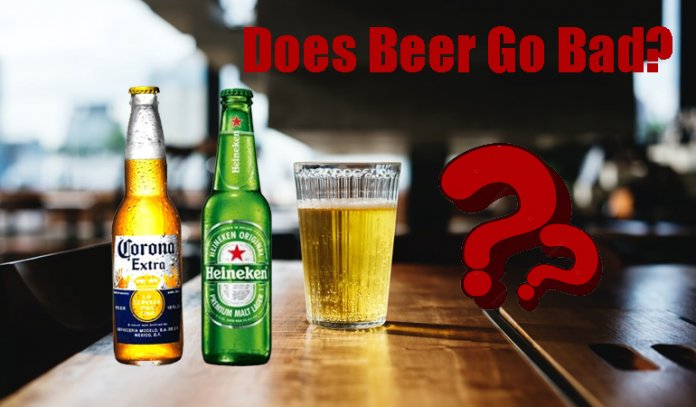You push a bunch of rotten vegetables around in the fridge, hoping to find treasure; something you can actually eat or drink. Jackpot! You find an old beer. You don’t recognize the label. Just how old is this beer anyway? It’s so old that it doesn’t have twist off cap; that’s not a good sign. You pop the top, lift the beer to your lips, and then you wonder… does beer go bad?
Are you wondering if beer can spoil like milk and actually make you sick, the answer is – no.
Even after decades, you can drink a safely drink a beer and not worry if it’ll be the last think you ever drink.
Contents
But unlike hard alcohol and wine, most beer doesn’t taste better with age. In fact, if a beer isn’t reasonably fresh, it will start to go off and taste stale. And pity the person who drinks a beer that was exposed to sunlight for a long period of time. A mouthful of skunky beer is something you’ll never forget.
Enemy #1 – Sunlight!
Beer has several natural enemies. The first is light, especially direct sunlight. Nothing will get a beer to go bad faster than days of direct sunlight. This is reason that most beer bottles are dark brown color. Although the clear Corona bottles show off the beautiful yellow color of the beer, the bright Mexican sunlight can get in and turn the beer against you.
The hops flowers used to give beer its flavor are extremely sensitive to the ultra-violet radiation streaming from the Sun. Even if exposed to sunlight for less than an hour, beer will undergo a chemical reaction that creates an organic compound called 3-methyl crotyl mercaptan. Give that a sip, and you’ll understand why a beer can be called “skunky”.
Most supermarkets use display cases lit by fluorescent light. They’re bright, and cheap to operate, but they blast out the ultraviolet radiation that can set a beer going skunky. If you want to best beer you can buy, look for bottles kept in a dark box, away from the sunlight and fluorescent lights. Cans are safe too.
Brewers can battle this process by using hydrogenated hop extracts instead of fresh hops, but then you’re not getting the best quality beer.
Enemy #2 – Temperature Changes
Beer wants to remain the same temperature as long as possible. When you’ve got imported beer from Europe that’s traveled across many timezones, who knows what kinds of temperature changes it’s had to experience: freezing winter, blasting deserts, hot trucks, beer store cooler, and finally your icebox.
Beer goes stale faster at higher temperatures. If your beer is allowed to warm up and stay that way, it shortens its life expectancy. You’ll want beer that was kept cool for as long as possible.
Find a beer that didn’t travel too far. This is one of the best reasons to go with a local microbrewery. In some cases, the total journey was from the brewery’s kegs to the shop front. The shorter distance your beer had to travel, the most consistent a brew you’re going to get.
Enemy #3 – Bacteria
Here’s an enemy that you don’t have a lot of control over. Bacteria is everywhere, and it’ll get growing as long as there’s a source of food, water and air. Fortunately, beer doesn’t support the kind of bacteria that’ll make you sick. So even if you’ve got a runaway bacteria colony going in your beer because of a brewer with poor quality standards, it’s not actually going to make you sick.
What the bacteria is going to do, however, is grow and put their waste products into the beer. This is something that you’ll eventually taste if enough builds up. Of course, alcohol is a natural inhibitor to the growth of bacteria – it’s one of the worst environments they can try to live in.
Enemy #4 – Air
This isn’t so likely a problem for any beer that you’re likely to buy from the store, but it can be a problem for homebrewers. The more oxygen you get, the more oxidizer you’re providing for bacteria in the beer. Not a big risk, because the brewer will make sure there’s very little air in each bottle.
Oxygen also changes the flavor of the beer. It oxidizes the beer and makes it go flat. This is why kegs of beer only last a few days before the flavor changes significantly. It’s much better to use carbon dioxide instead of oxygen to drive the beer, since it won’t change the flavor.
Enemy #5 – Low Alcohol Content
Darker beers with higher alcohol levels are often brewed at higher temperatures with a greater percentage of darker malted and unmalted grains and more hops. Beers with a higher percentage of alcohol, like 7%, can actually change and improve with age, bringing out some of the more fruity and winey flavors. The lower 4-5% alcohol beers that age will go stale and skunky over time. If you keep the beer cooled, it’ll last for as long as possible.
How Long Will Beer Taste Good?
Regular beer will last about 6 weeks in normal conditions. If you treat it carefully, keep it cool and out of sunlight, you can make it last even longer. But after a few months, even the most carefully nurtured bottle of beer is going to go “off”. You can buy bottle-conditioned beer, which contain living years, and can be stored at room temperature out of sunlight for up to 5 years.
There are also higher-alcohol beers which have been known to improve with age, easily lasting 5-10 years. One manufacturer boasts that their beer will still taste good after 20 years.
How Can You Make Beer Last Longer?
If you’ve been reading this far, you’ve probably got the answers to keeping your beer lasting as long as possible. Keep it cool, in a cellar or refrigerator. Minimize its exposure to sunlight. And if you’re planning on keeping your beer around a few years, get something with a higher alcohol content that won’t go bad, and might actually improve with time.


